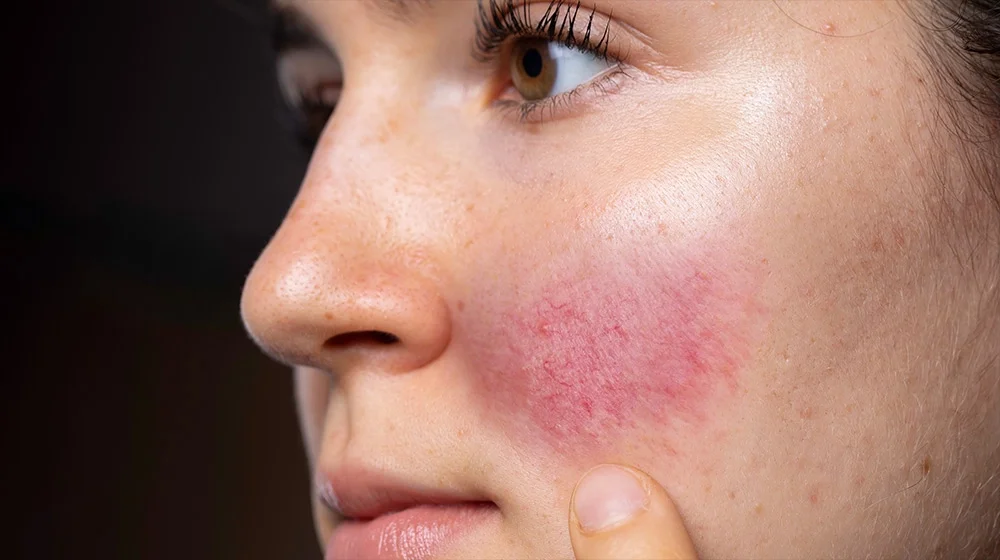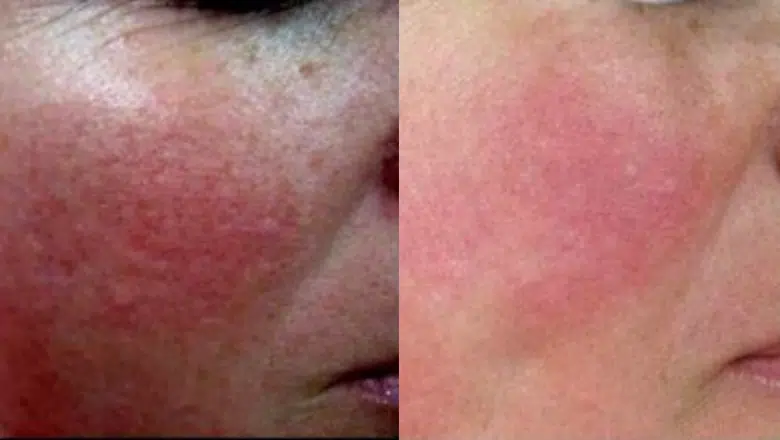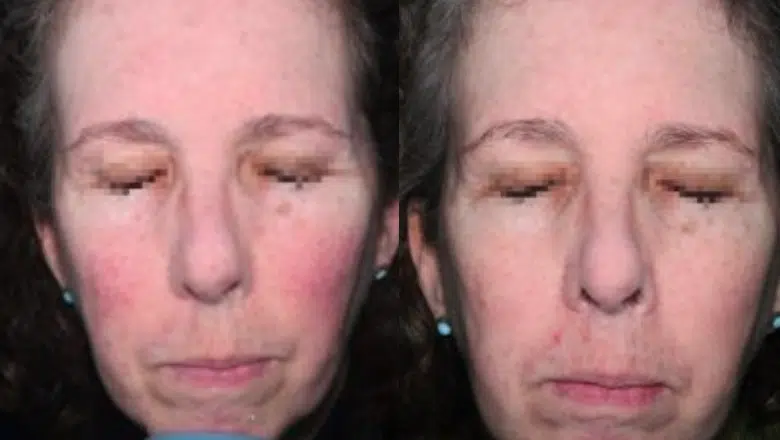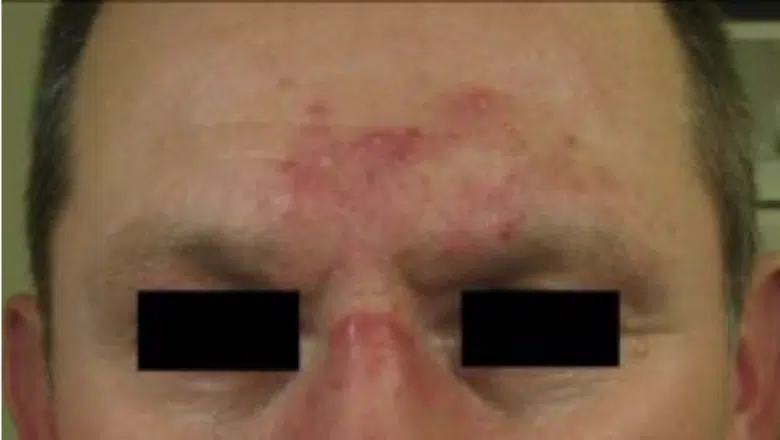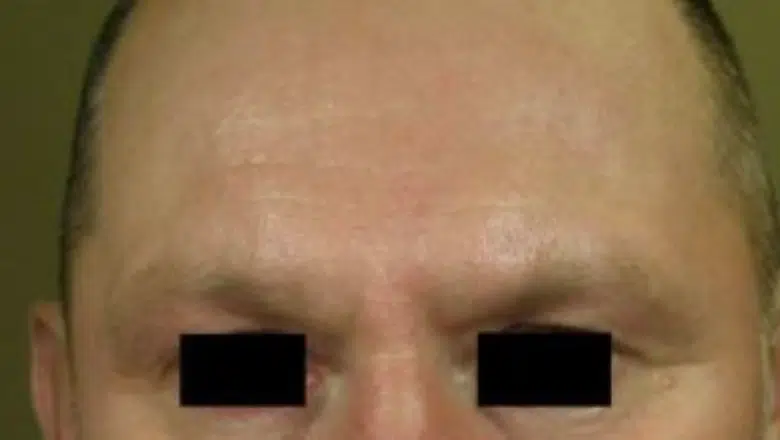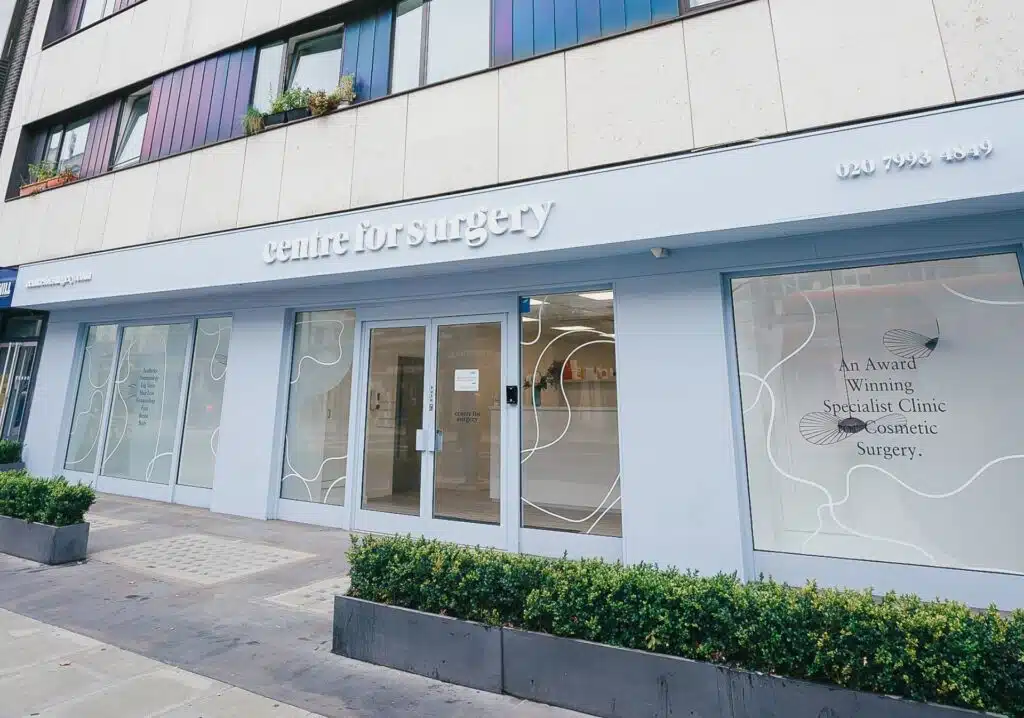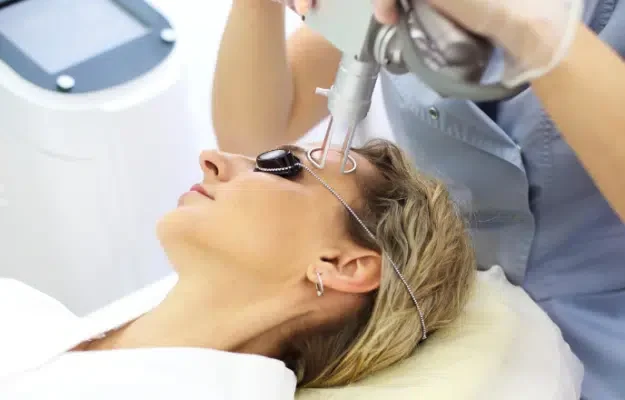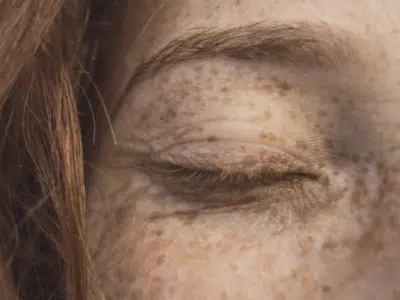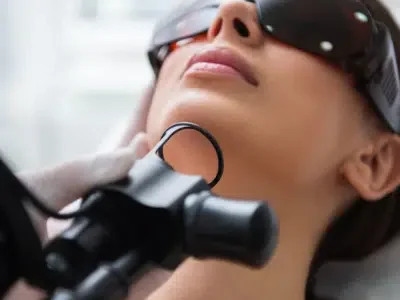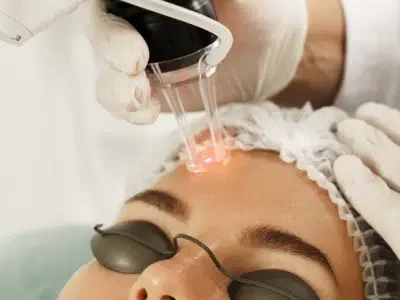Laser Rosacea treatment in London
Experience renewed confidence with our laser treatment for rosacea, where cutting-edge technology meets personalised care to improve your skin’s appearance and health dramatically
What is Rosacea?
Rosacea is a prevalent skin condition that can be triggered by various factors, affecting a significant portion of the population. It’s most commonly recognised by a distinct redness on the facial skin, with a higher incidence reported among individuals with lighter skin tones. This condition is not just limited to facial redness; it can manifest in several other symptoms, making it a multifaceted skin issue.
In some cases, the redness associated with rosacea can intensify, leading to a darker hue and a noticeable change in the skin’s texture, often described as lumpy or thickened. This progression of symptoms can vary from person to person, but several common signs are frequently observed:
- Burning and Stinging Sensations: Individuals with rosacea often report a burning or stinging feeling in their facial skin. This can be a persistent and uncomfortable symptom, impacting the quality of life.
- Dry Skin: The affected skin areas can become notably dry, contributing to a rough or scaly texture. This dryness can exacerbate the redness and lead to further irritation.
- Dilated and Visible Blood Vessels: One of the hallmarks of rosacea is the appearance of small, dilated blood vessels on the face, particularly around the nose and cheeks. These vessels, also known as telangiectasias, can become more pronounced over time.
- Acne-Like Skin Eruptions: Rosacea can cause spots, bumps, and pustules that closely resemble acne. These blemishes can vary in severity and are often a significant cosmetic concern for those affected.
- Sensitivity to Light: A heightened sensitivity to light, especially bright sunlight, is another symptom experienced by some individuals with rosacea. This can lead to discomfort and a need to avoid certain light conditions.
- Ocular Complications: In some cases, rosacea can extend to the eye area, leading to painful swelling and infection. This can include symptoms such as redness, irritation, and a feeling of grittiness in the eyes, sometimes referred to as ocular rosacea.
Rosacea Laser treatment Before & After Photos
Case 1:
Case 2:
Case 3:
Laser Treatment for Rosacea: Enhancing Skin Appearance and Texture
Laser therapy for rosacea is a highly individualised treatment, owing to the diverse ways in which the condition manifests. At Centre for Surgery, we utilise advanced laser technology to effectively target and alleviate some of the most challenging symptoms of rosacea, such as visible blood vessels, persistent redness, and acne-like breakouts.
One of the key tools is the Fotona Nd:YAG laser. This sophisticated device is designed to emit laser light at varying pulse durations, allowing us to precisely target different layers of the skin for optimal results. The mechanism behind this technology is quite fascinating. The laser light is specifically absorbed by haemoglobin – the component in red blood cells – which leads to the breakdown of these cells. This process effectively collapses the superficial blood capillaries, significantly reducing their visibility on the skin’s surface.
Beyond addressing blood vessels, the Fotona Nd:YAG laser is also adept at targeting specific skin lesions associated with rosacea. This includes spots, bumps, or boils that can mar the skin’s appearance. The laser’s precision ensures that these blemishes are treated effectively, while also promoting a more uniform skin pigmentation. This dual-action approach not only addresses the immediate cosmetic concerns but also contributes to the overall health and texture of the skin.
Patients undergoing laser rosacea treatment at our Marylebone clinic can expect an immediate and lasting improvement in their skin’s appearance and texture. The benefits of this treatment extend beyond just aesthetic enhancement; many of our patients report a significant boost in self-confidence and overall satisfaction with their skin’s condition.
What to Expect - Expert Laser Rosacea Treatment at Centre for Surgery
Essential Pre-Treatment Consultation for Laser Rosacea Therapy
Before initiating laser therapy for rosacea, a detailed and comprehensive consultation with our clinicians is an indispensable step. This initial consultation is critical to ascertain your suitability for Fotna laser treatment. Here’s what you can expect during the process:
Health Evaluation: Our clinicians will conduct a thorough review of your overall health status. This includes understanding any existing health conditions that could affect your treatment or be affected by it.
Medication and Allergy Review: We will take a complete inventory of any medications you are currently taking, as well as any known allergies. Certain medications can increase photosensitivity or have other interactions with laser therapy, and allergies could influence the type of treatment you receive.
Discussion of Concerns: It is important to communicate your specific concerns and what you hope to achieve with the treatment. Our clinician will discuss the main areas of concern on your skin to determine if laser therapy is the most appropriate and effective option for you.
Assessment for Laser Treatment: Your skin type, tone, and the severity of the rosacea symptoms will be evaluated to ensure that the laser treatment is tailored to your individual needs. This ensures the highest efficacy and safety during the procedure.
Test Patch: Should laser therapy be deemed suitable for you, our clinicians will perform a test patch. This is a critical step to ensure that your skin does not have an adverse reaction to the laser. The test patch is a standard safety procedure that helps predict how your skin will react to a full treatment session.
Personalised Rosacea Laser Treatment: Protocol and Duration
At Centre for Surgery, we recognise that each individual’s experience with rosacea is unique, and as such, we offer bespoke treatment plans tailored to the specific type and symptoms of your condition. Our approach to treating rosacea with laser therapy is meticulously customised to address the particular challenges you face with your skin.
Customised Treatment Protocols: Depending on the nature of your rosacea, our laser treatment can be fine-tuned to target a variety of symptoms:
- Flushing or Redness: For those experiencing pronounced facial redness, the laser settings are adjusted to specifically target and reduce the appearance of this symptom, providing a more even skin tone.
- Thread Veins: Our laser therapy is also effective in treating thread veins (telangiectasia), which are small, visible blood vessels that can appear on the face as part of rosacea.
- Spots: If your rosacea presents with spots or an acne-like condition, the laser can be calibrated to treat these areas, helping to clear the skin.
- Nasal Thickening: For individuals who suffer from rhinophyma, which is a thickening of the skin on the nose, laser therapy can help reshape and smooth the area, significantly improving the skin’s appearance.
Duration of Treatment: The typical duration for a full rosacea laser treatment session at our clinic ranges between 60 to 90 minutes. This time frame allows for a thorough application of the laser technology, ensuring each targeted area receives the appropriate level of treatment. It also includes time for any necessary preparation and post-treatment care.
Recovery and Achieving Optimal Results from Rosacea Laser Treatment
Following your tailored rosacea laser treatment at Centre for Surgery, you can anticipate a noticeable enhancement in your skin’s clarity and a reduction in sensitivity to external factors. To ensure a smooth and successful recovery, we provide comprehensive aftercare guidelines tailored to your individual treatment plan.
Post-Treatment Care: Protecting your skin from excessive sun exposure is essential, which can aggravate the treated areas and impact healing. We advise wearing a high-SPF sunscreen for at least the first two weeks post-treatment and continuing to protect your skin as part of your regular skincare routine.
Expected Outcomes: Your personalised laser treatment is designed to target and alleviate the specific symptoms of rosacea you experience. As a result of the treatment, you can expect:
- A significant reduction in the appearance of broken and visible blood vessels and capillaries on the face.
- Fewer acne breakouts, as the laser helps to manage inflammatory components of rosacea.
- An improvement in overall facial redness and pigmentation, leading to a more even skin tone.
- The removal of dead skin cells from the skin’s surface, contributing to a smoother skin texture.
Visible Results and Maintenance: Results typically become evident approximately 4 to 6 weeks after treatment, as the skin heals and rejuvenates. To achieve the most effective and lasting improvement, we recommend a minimum of three treatment sessions. These initial sessions lay the groundwork for significant changes in the skin’s appearance and health.
Additional sessions are advised every 12 to 18 months to maintain these improvements. This ongoing care is crucial in managing the chronic nature of rosacea and sustaining the treatment’s benefits over time.
How Many Sessions of Laser for Rosacea Will I Need?
The management of rosacea with laser therapy is a process that typically unfolds over several sessions to achieve the best outcomes. Based on clinical experience and patient outcomes, it is often recommended to undertake a series of three laser therapy treatments. These sessions are ideally spaced 4 to 6 weeks apart, allowing the skin sufficient time to heal and respond to the treatment.
The initial trio of treatments aims to address the visible symptoms of rosacea, such as redness, visible blood vessels, and any acne-like eruptions. As each person’s skin reacts differently, this interval is crucial to tailor subsequent sessions based on the individual’s response to the laser therapy.
After the initial intensive treatment phase, maintenance sessions play a vital role in the ongoing management of rosacea symptoms. These sessions are typically recommended every 6 to 12 months, depending on the severity of the condition and the individual’s skin response to the initial treatments. Maintenance treatments help to keep the symptoms at bay and prolong the positive effects of the laser therapy.
The exact number of sessions can vary from patient to patient. Some individuals may see significant improvement after just a few treatments, while others might require additional sessions to achieve their desired results. The best course of action will be determined during consultations and assessments by a skin specialist, who can provide a treatment plan tailored to your specific needs.
How Much Does Laser Treatment for Rosacea Cost?
Laser Rosacea Treatment in London: Excellence at Centre for Surgery
FAQs
-
Why choose laser treatment for rosacea?Laser treatments deploy targeted heat energy to soothe the redness and reduce the visibility of damaged blood vessels caused by rosacea. The Fotona SP Dynamis laser, in particular, is known for its efficiency and comfort, providing dramatic and enduring results that have made it a go-to option for many seeking relief from rosacea.
-
Is rosacea genetic?Yes, rosacea does seem to have a family connection. If you've noticed that several people in your family tree share the same skin issues, it could very well be that you've inherited genes predisposing you to rosacea. Like many other traits that run in families, from eye colour to certain health conditions, rosacea can be one of those family features passed from one generation to the next.
-
Can rosacea be considered a serious health issue?Generally, rosacea is more of a nuisance than a danger. However rosacea can cause complications if it starts to involve the eyes or eyelids. In rare, severe cases, it can lead to vision issues. Most often, though, it's the discomfort and the impact on appearance that drives people to seek treatment rather than any immediate health danger.
-
What leads to the development of rosacea?The root cause of rosacea continues to elude the medical community, but there's a consensus that certain elements can ignite or exacerbate its symptoms. It's like a puzzle where pieces such as alcohol consumption, indulging in spicy foods, partaking of hot beverages, sun exposure, weather extremes, vigorous physical activity, and stress fit together to provoke a flare-up. These triggers seem to prompt a dilation of blood vessels or inflammatory response in susceptible individuals. It's also hypothesised that genetic predisposition, immune system factors, and even microscopic mites commonly found on the skin could play roles in the development of rosacea.
-
What are the typical symptoms associated with rosacea?Rosacea often declares its presence with a characteristic redness and heightened sensitivity of the facial skin. Imagine a constant flush or blush that hints at an underlying turmoil within the skin. This can be accompanied by a spectrum of other symptoms such as a parched, tight skin texture, puffiness, yellowish-orange patches, uncomfortable eyelids, crusty lashes, and in some cases, a thickening of the skin, particularly around the nose, known as rhinophyma. These symptoms can vary widely among individuals and can often be mistaken for other skin conditions, which is why understanding and correctly identifying rosacea is so important.
-
Could you detail the various forms of rosacea?Rosacea's four different forms are as varied as the individuals it affects:
Erythematotelangiectatic Rosacea: Characterised by persistent facial redness with visible blood vessels.
Papulopustular Rosacea: Marked by red, swollen bumps and whiteheads, creating a landscape of inflammation on the cheeks, chin, and forehead.
Phymatous Rosacea: A rarer form that leads to skin thickening, often resulting in a bulbous nose, and tends to be more common in men.
Ocular Rosacea: Targets the eyes, leaving them looking bloodshot and watery, often with a burning sensation and dryness. -
Can you explain the four stages of rosacea?Pre-Rosacea: The journey often starts with occasional blushing or redness, typically prompted by triggers such as exercise or certain foods.
Mild Rosacea: As the journey continues, the facial redness becomes a more persistent companion, lingering for at least half an hour or more after the trigger has subsided, with visible blood vessels sometimes remaining dilated.
Moderate Rosacea: Progressing further, the bouts of redness decide to stay longer, stretching out for days or weeks, even when the original trigger is long gone. This stage may also invite swelling and the appearance of inflammatory spots that resemble acne.
Severe Rosacea: In the most challenging terrain, intense and persistent facial flushing occurs, accompanied by significant inflammation and discomfort. The blood vessels may show extensive damage and are clearly visible. -
Does hydration have an impact on rosacea?Absolutely, staying well-hydrated is like providing a soothing balm for your skin. Adequate water intake ensures your skin remains supple and may alleviate the dryness associated with rosacea. Additionally, sipping cool or iced water acts like an internal cooling mechanism, potentially helping to prevent one of the common triggers of rosacea: overheating.
-
Is there a way to prevent rosacea?While there's no fail-safe method to completely prevent rosacea, you can certainly embark on a journey to minimise the frequency and intensity of flare-ups by understanding and avoiding your personal triggers. These may include, but are not limited to, direct sunlight, emotional stress, intense exercise, hot or cold weather extremes, steaming hot drinks, alcoholic beverages, and spicy foods.
-
What are the consequences of not treating rosacea?If rosacea is left untreated, it tends to become more severe in its appearance. Episodes of redness can stretch out for longer periods, potentially leading to a permanent blush across the face. The cheeks may also develop spider veins, and some individuals might experience acne-like breakouts.
-
How much time does each rosacea laser treatment session require?Typically, each session lasts somewhere between 45 to 60 minutes, though this can vary depending on how extensive the affected area is and how your skin is responding to the treatment.
-
When will the improvements from rosacea laser treatment become noticeable?After treatment, it's normal to have a bit of redness. This usually fades away after a few hours. As the days pass, you'll start seeing a marked improvement in your skin's condition. With each subsequent treatment, expect your skin to look increasingly clearer and feel less sensitive.
-
Are the improvements from rosacea laser treatments permanent?While the positive changes from rosacea laser treatments can feel like a breath of fresh air, they aren't a permanent fix. Regular maintenance treatments, spaced every 6 to 12 months, along with a solid skincare routine, can help you keep rosacea symptoms in check and maintain the health and appearance of your skin.

